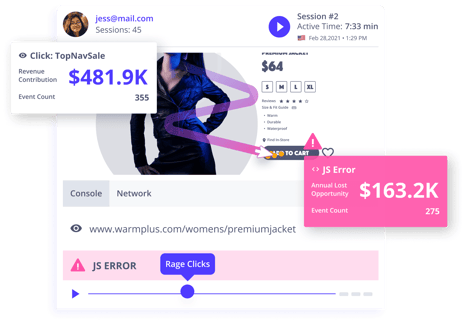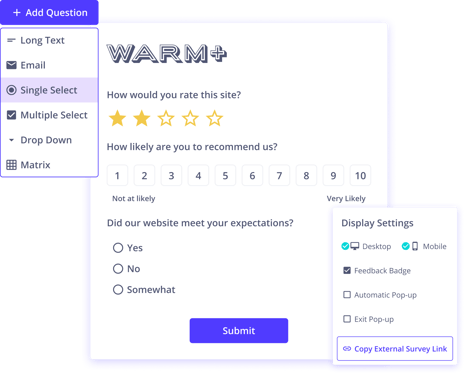Every customer interaction leaves an impact on your business. So, do you help customers achieve their goals effortlessly in these interactions? Or do you make them jump through multiple hoops to resolve their issue? According to a study by Gartner, 96% of respondents who had high-effort experiences (like having to repeat information or contact a company more than once) reported being disloyal to a company. Therefore, the golden rule to creating loyal customers with every interaction is to make their lives easier.
In this blog, we look at the customer effort score and how it’s measured, 3 obstacles to using CES, and finally, how you can overcome these obstacles to improve your customer experience and drive more revenue.
Defining and measuring CES
Customer effort score (CES) is a CX metric that measures how easy or hard it was for a customer to interact with your business and accomplish their goals. These interactions could vary from resolving their problems, finding answers to their questions, returning a purchase, and much more. To measure customer effort scores, customers are typically asked to rate their level of effort after any interaction. Before we proceed to calculate CES, let us check out the different ways to capture the consumer responses:
- Likert scale
A Likert scale captures the intensity of agreement or disagreement with a non-question statement. Customer responses lie on a 7-point symmetric scale, ranging from ‘Strongly disagree’ to ‘Strongly agree.’ Each response is correlated to a number to calculate CES, with ‘Strongly disagree’ being 1 and ‘Strongly agree’ equal to 7.

Using a Likert scale to capture customer responses
- Numerical scale
For a numerical scale, respondents answer a question on a numbered scale ranging from 1 to 10. 1 indicates that the customer had to put in a lot of effort in their interaction with the business, while 10 means it was almost effortless.

Using a numerical scale to capture customer responses
- Emoticon scale
Sometimes, responding with emojis rather than numbers or labels is easier and more intuitive. In an emoticon scale, numbers and words are replaced by unhappy, indifferent, and happy emoji faces to capture responses. It is universally understandable and convenient to capture customer experience after simple transactions like completing payment at a kiosk.

Using an emoticon scale to capture customer responses
For complex transactions that require more nuance than emojis can provide, it’s always preferable to use Likert or Numerical scales. In such cases, divide the total sum of responses by the number of respondents to calculate the customer effort score. In the case of emoticon scales, calculate the percentage of happy faces among the total responses. A higher CES indicates less effort is put in by customers, resulting in a better customer experience.
While CES is a good metric to predict customer loyalty and future purchase behavior, there are 3 major obstacles you need to overcome to improve your customer experience:
Obstacle #1: Lack of a holistic picture
CES surveys measure only specific experiences while interacting with a business, like after online checkouts or customer sign-ups. The responses are captured at a transactional level; hence, CES cannot provide a broader picture of the customer relationship with your business.
Obstacle #2: Inability to analyze problems
CES is great at understanding what aspects of your business customers find difficult to use, but it does not explain its reasons. Without having any user context into customers' problems, you will always be confused about why customers find something difficult.
Obstacle #3: Inaccurate results
If you fail to send your CES surveys immediately after a customer interaction, customers may find it difficult to recollect their experiences, leading to inaccurate results. Moreover, customer effort scores don’t consider important factors that affect your customer experiences like cost and product quality.
Gaining user context with Auryc
We now know that customer effort scores are valuable only when you have user context to understand why certain aspects of your business aren’t working. Only then can you take corrective action to improve customer experiences. So how can you gain user context to understand your customer better? Enter Auryc.
Auryc is a customer experience intelligence platform that optimizes every customer experience across web and mobile to drive more revenue. It captures 100% of engagement events and content for customers and visitors - a high fidelity record of users’ digital journeys, including all clicks, views, swipes, user input, system performance data plus CES, NPS surveys, and feedback. Some of Auryc’s valuable features that help you understand user context are:
- Session replays to get deep user context
In addition to your CES score, you can use session replays to record detailed user sessions and visualize where your customers struggle. As a result, you can understand all your customer frustrations, from rage clicks to loss of interest, and solve them faster

Understand user context with detailed session recordings
- Performance and revenue impact reports improve faster
Auryc Insights aggregates all site visitor data so that you can gain insights into the frequency, recency, and severity of issues that impact loyalty, performance, and revenue. So you don’t just stop identifying a problem using CES but can also dig deeper to solve that problem.
.png?width=465&name=Insight%20Reports%20(1).png)
Analyze and solve problems faster
- Customer feedback/VoC to accurately measure CES and other CX metrics
Voice of the Customer (VoC) allows you to collect customer feedback at every digital touchpoint, enabling you to identify what your customers want the most. You can trigger in-the-moment surveys to help capture customer responses efficiently and thereby accurately measure CES.

Understand user needs with VoC
- Smart funnels/Path analysis to understand user journeys
You can create smart funnels to get quantitative and qualitative data across user behavior, business, and technology. In addition, you can examine how visitors move through your website using pathing analysis. Using smart funnels and pathing analysis, you can identify the primary drivers for conversions and the critical blockers for dropped users.
Auryc is changing the way companies build better experiences for their customer. Whether an analyst or a product marketer, you can use Auryc’s features to create memorable customer experiences. And that too, with no coding knowledge because Auryc is a no-code analytics platform! You can leverage the powerful suite of tools that Auryc provides by booking a demo today.


